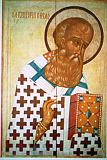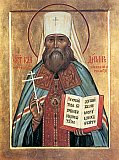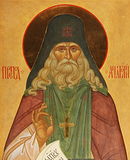

| Previous day | Next day |
| Old Style
January 25
|
Thursday |
New Style
February 7
|
| 37th Week after Pentecost. Tone 3. | No fast.
|
![]() St. Gregory the Theologian, archbishop of Constantinople (389). St. Anatole I (Zertsalov), elder, of Optina Monastery (1894).
St. Gregory the Theologian, archbishop of Constantinople (389). St. Anatole I (Zertsalov), elder, of Optina Monastery (1894). ![]() New Hieromartyr Vladimir, metropolitan of Kiev, protomartyr of the Communist yoke in Russia (1918).
New Hieromartyr Vladimir, metropolitan of Kiev, protomartyr of the Communist yoke in Russia (1918).
Martyrs Felicitas of Rome and seven sons: Januarius, Felix, Philip, Silvanus, Alexander, Vitalis, and Martial (ca. 164). St. Publius, ascetic, of Euphratensis in Syria (ca. 380). St. Mares the Singer, of Omeros near Cyrrhus (ca. 430). St. Moses, archbishop of Novgorod (1362). St. Gregory, abbot, of Staro-Golutvin Monastery and bishop of Kolomna (15th c.).
New Hieromartyrs Peter (Zverev), archbishop of Voronezh (1929) and Basil (Zelentsov), bishop of Priluki (1930). New Martyr Abbess Margaret (Gunaronulo) of Menzelino (1918). New Martyr Athanasia (Lepeshkin), abbess of the Smolensk Hodigitria Convent, near Moscow (1931).
Icons of the Most Holy Theotokos “Assuage My Sorrow” and “Unexpected Joy.” (1640)
St. Castinus, bishop of Byzantium (240). St. Bretanion (Vetranion), bishop of Tomis in Moesia (ca. 380). St. Apollo of the Thebaid, monk (4th c.). Hieromartyr Praejectus, bishop of Clermont (676). St. Demetrius, the skevophylax (“keeper of the sacred vessels”), of Constantinople (8th c.). New Martyr Auxentius of Constantinople (1720). St. Gabriel, bishop of Imereti (Georgia) (1896).
Repose of Archpriest Sergius Orlov of Akulovo (1975).
Thoughts for Each Day of the Year
According to the Daily Church Readings from the Word of God
By St. Theophan the Recluse

Thursday. [Eph. 4:14-19; Mark 11:27-33]
The Saviour proves that He was sent from heaven using the testimony of John the Forerunner. They were silent, for there was nothing to say to the contrary, yet they did not believe. Another time He proved the same thing through His deeds, and they thought up a new twist: [He casteth out devils] by the prince of the devils (Mt. 9:34, Mk. 3:22). But when this twist was exposed to be completely inappropriate, they again were silent, but nevertheless did not believe. Thus unbelievers never believe no matter what you tell them and how convincingly you prove the truth. They cannot say anything to the contrary, while nevertheless they do not believe. One might say that their mind is paralyzed, since they reason sensibly about other things. Only when the issue touches upon faith do they become confused in their concepts and words. They also become confused when they present their outlooks as a substitute for the tenets of faith given by God. Here their doubt raises such a buttress that it is like a firm cliff. If you hear their entire theory through, you will see that a child could figure out that this is a spider’s web; but they do not see it. O unfathomable blindness! One can explain the obstinacy of unbelievers as their not wanting to believe, but where does this come from? Where does it get such power that it makes a sensible man consciously cling to an illogical form of thoughts? This is darkness. Is it not from the father of darkness?
Articles
 Venerable Anatole I of OptinaFrom a very early age, Alexis wanted to become a monk. He even thought about going to the Roslavl forests to live with the hermits at that place. |
 St. Vladimir, Metropolitan of Kiev and GallichThe holy Metropolitan Vladimir of Kiev was the first bishop to be tortured and slain by the Communists at the time of the Russian Revolution. |
 St. Publius the Ascetic of SyriaSaint Publius of Syria was born in the city of Zeugma on the Euphrates and was a senator. |
 St. Mares the Singer in SyriaSaint Mares the Singer lived in a hut in fasting and prayer for thirty-seven years in the village of Homeron, not far from the city of Cyrrhus in Syria. |









